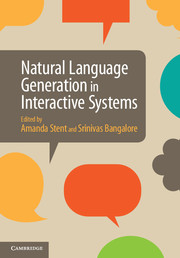Book contents
- Frontmatter
- Contents
- List of contributors
- 1 Introduction
- Part I Joint construction
- 2 Communicative intentions and natural language generation
- 3 Pursuing and demonstrating understanding in dialogue
- 4 Dialogue and compound contributions
- Part II Reference
- Part III Handling uncertainty
- Part IV Engagement
- Part V Evaluation and shared tasks
- Author index
- Subject index
- References
3 - Pursuing and demonstrating understanding in dialogue
from Part I - Joint construction
Published online by Cambridge University Press: 05 July 2014
- Frontmatter
- Contents
- List of contributors
- 1 Introduction
- Part I Joint construction
- 2 Communicative intentions and natural language generation
- 3 Pursuing and demonstrating understanding in dialogue
- 4 Dialogue and compound contributions
- Part II Reference
- Part III Handling uncertainty
- Part IV Engagement
- Part V Evaluation and shared tasks
- Author index
- Subject index
- References
Summary
Introduction
The appeal of natural language dialogue as an interface modality is its ability to support open-ended mixed-initiative interaction. Many systems offer rich and extensive capabilities, but must support novice or infrequent users. It is unreasonable to expect untrained users to know the actions they need in advance, or to be able to specify their goals using a regimented scheme of commands or menu options. Dialogue allows the user to talk through their needs with the system and arrive collaboratively at a feasible solution. Dialogue, in short, becomes more useful to users as the interaction becomes more potentially problematic.
However, the flexibility of dialogue comes at a cost in system engineering. We cannot expect the user's model of the task and domain to align with the system's. Consequently, the system cannot count on a fixed schema to enable it to understand the user. It must be prepared for incorrect or incomplete analyses of users' utterances, and must be able to put together users' needs across extended interactions. Conversely, the system must be prepared for users that misunderstand it, or fail to understand it.
This chapter provides an overview of the concepts, models, and research challenges involved in this process of pursuing and demonstrating understanding in dialogue. We start in Section 3.2 from analyses of human–human conversation. People are no different from systems: they, too, face potentially problematic interactions involving misunderstandings. In response, they avail themselves of a wide range of discourse moves and interactive strategies, suggesting that they approach communication itself as a collaborative process wherein all parties establish agreement, to their mutual satisfaction, on the distinctions that matter for their discussion and on the expressions through which to identify those distinctions. In the literature, this process is often described as grounding communication, or identifying contributions well enough so that they become part of the common ground of the conversation (Clark and Marshall, 1981; Clark and Schaefer, 1989; Clark and Wilkes-Gibbs, 1990; Clark, 1996).
Information
- Type
- Chapter
- Information
- Natural Language Generation in Interactive Systems , pp. 34 - 62Publisher: Cambridge University PressPrint publication year: 2014
